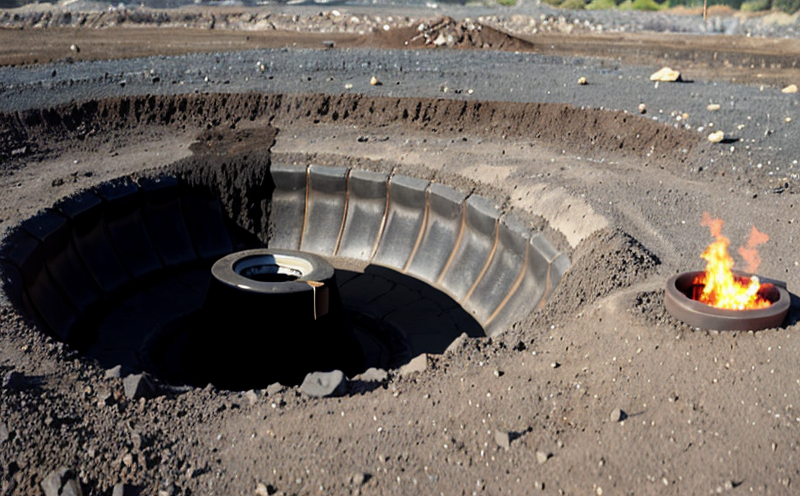ASTM D1857 Fusibility of Coal Ash Testing
The ASTM D1857 test method is a critical procedure used in the mining sector to evaluate the fusibility properties of coal ash. This property is essential for understanding how coal ash behaves during combustion processes, particularly in boilers and other thermal systems. The test provides valuable insights into the potential for slagging and fouling within these systems.
The process involves heating a small sample of coal ash under controlled conditions to determine its melting point. The specimen is placed in a crucible with a specified mixture of sand and limestone, which simulates the conditions found in boiler furnaces. The crucible is then heated gradually until it reaches a specific temperature (typically around 1200°C). During this process, observations are made regarding the flow and shape change of the coal ash.
The results from this test help quality managers and compliance officers ensure that the coal ash meets regulatory standards for environmental protection. R&D engineers use these data points to refine combustion processes and reduce emissions. Additionally, procurement professionals can leverage this information when selecting suppliers who meet stringent fusibility requirements.
Understanding the fusibility of coal ash is crucial because it directly impacts boiler performance and efficiency. Poorly fused coal ash can lead to operational issues such as reduced heat transfer rates or increased maintenance costs due to fouling. By conducting ASTM D1857 tests regularly, organizations can proactively address these challenges and maintain optimal operating conditions.
The test procedure itself requires precise sample preparation and handling techniques to ensure accurate results. Specimens must be carefully weighed and ground into a fine powder before being mixed with the sand and limestone matrix. The crucible containing the mixture is then placed in an induction furnace for heating. Throughout the process, careful observation ensures that any changes in form or appearance are recorded accurately.
ASTM D1857 also specifies detailed reporting guidelines to communicate findings effectively. Reports typically include descriptions of observed behavior during heating, including melting points and final forms attained by the coal ash. These details enable stakeholders across industries to interpret results correctly and apply them appropriately in various applications ranging from power generation to industrial processing.
In summary, ASTM D1857 fusibility testing is a cornerstone practice within the mining industry focused on optimizing combustion efficiency while minimizing environmental impacts. Its application extends beyond just coal ash but also includes other types of fuel-related materials where similar properties play significant roles in operational success.
Scope and Methodology
The scope of ASTM D1857 covers the determination of the fusibility properties of coal ash, which is defined as the ability to melt or fuse under controlled heating conditions. This test method applies primarily to industrial applications involving combustion processes where coal ash may interact with furnace walls or other components.
- Sample Preparation: The procedure begins by selecting representative samples of coal ash according to standard practices outlined in ASTM standards.
- Mixing Mixture: A predetermined amount of sand and limestone are combined with the sample, forming a cohesive mixture that approximates real-world conditions experienced during combustion.
- Furnace Heating: The prepared mixture is placed into an induction furnace where it undergoes gradual heating until reaching approximately 1200°C. Temperature increases should be measured accurately throughout the process to ensure consistent results.
The methodology emphasizes accuracy and precision in both sample preparation and measurement techniques to yield reliable data reflecting true properties of the coal ash being tested.
Benefits
- Enhanced Boiler Efficiency: Understanding fusibility helps prevent slagging and fouling, leading to improved heat transfer efficiency.
- Pollution Reduction: By minimizing the formation of harmful compounds during combustion, this test contributes to better air quality outcomes.
- Cost Savings: Proactive management based on test results can reduce maintenance costs associated with cleaning and replacing damaged equipment.
- Compliance Assurance: Ensures that coal ash products comply with relevant environmental regulations and industry standards.
Why Choose This Test
Selecting ASTM D1857 for fusibility testing offers several advantages that make it indispensable for mining companies operating in the coal and fossil fuel sectors. One key advantage is its ability to provide actionable data regarding the behavior of coal ash under specific heating conditions, which can be used to optimize combustion processes. This optimization translates into higher thermal efficiency rates and reduced fuel consumption.
Another important benefit lies in the contribution it makes towards meeting environmental compliance requirements set forth by regulatory bodies worldwide. By ensuring that coal ash products meet specified limits for certain constituents, this test supports efforts aimed at reducing greenhouse gas emissions and other pollutants associated with fossil fuel utilization.
The third significant advantage pertains to enhanced product quality control measures. Through regular testing, manufacturers gain deeper insights into variations among batches of raw materials used in production processes, allowing them to make informed decisions about sourcing strategies and process improvements.
Lastly, the test serves as a valuable tool for research and development activities focused on developing new technologies designed specifically for cleaner burning fuels or alternative energy solutions. It provides essential input needed to design systems capable of handling diverse types of coal ash while maintaining optimal performance levels.





